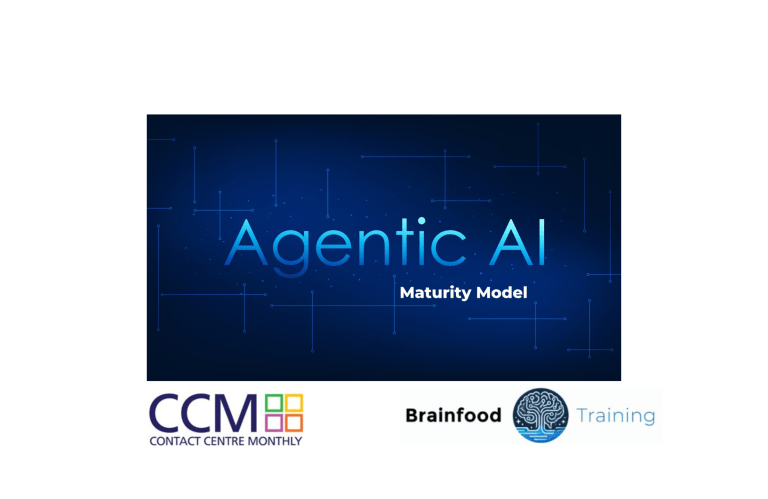Picking The Right Mental Model
This is the third article in the Agentic AI series. The learning outcome for the series is to seed foundation understanding about the current generation of AI capability. Explained of course, in language suited to non technically minded leaders and organisation influencers.
The aim of this article is twofold.
First explain how Agentic AI is defined by a distinguishing set of competencies. Then explain the degree to which these are active or not in the exploding world of AI agents.
Maturity models are an excellent way to quickly make sense of these distinctions. Most are visualised as five stage evolutions. From ‘simple to complex’ and ‘commonplace to rare’.
I’ve found these models very useful for developing an accurate foundation understanding of Agentic AI. The signal:noise ratio in the market is so intense that business case success is being actively undermined by lazy terminology and conflated claims.
Deconstructing Agentic AI into five evolutionary stages clarifies the degree to which those essential competencies are deployed, and the significant uplift required to move from one stage of maturity to the next.
The characteristics that distinguish Agentic AI from traditional and generative AI are:
- Proactive Agency – Takes initiative rather than waiting for prompts
- Goal Orientation – Pursues defined objectives through planning and execution
- Autonomous Decision-Making – Makes independent choices within operational parameters
- Environmental Interaction – Perceives, reasons about, and acts upon the world
- Persistent Operation – Maintains context and memory across extended sessions
- Adaptive Behaviour – Learns from outcomes and adjusts strategies accordingly
A crucial insight to take on board is that only stage four and five agent solutions qualify as agentic in terms of these distinguishing characteristics.

Beware False Profits
Do these distinctions matter? Yes, because of widespread “agent washing” where traditional automation is being rebranded as agentic AI.
This has become widespread and causes market confusion. Here are some live examples of traditional capabilities being rebranded as agentic AI.
Retail and E-commerce
- Product recommendation engines → “Hyper-personalized shopping agents”
- Order tracking systems → “Proactive customer care agents”
- Multi-channel support → “Seamless omnichannel agents”
- Escalation workflows → “Smart escalation handling agents”
Telecommunications
- Network monitoring systems → “Agentic AI for proactive outage management”
- Standard CRM integration → “Telecom-specific agents for enhanced customer service”
Gartner has consistently issued warnings that their analysis shows only around 130 genuine agentic AI products today versus thousands of vendor claims. That’s quite a claim! They know a goldrush when they see one.
Why? It’s all rebranding to gain SEO and pipeline.
Therefore, the opportunity to fall prey to ‘agent washing’ is real. However the more informed decision makers become, the less likely they are to buy repacked capability at inflated prices believing it has new levels of transformational potential.
Reaching The Agentic North Star
There are other compelling reasons to build your mental model of agentic AI around an evolutionary timeline.
Here’s the second one.
Maturity models visually communicate an important truth. Every stage is foundational to later stages. In this sense you can’t leapfrog. But you can evolve at speed with the right mindset, skill and leadership when ‘being first’ becomes the strategic priority.
The next point is that Agentic AI remains aspirational.
- Current State (2025): Most “agentic” systems operate at Stage 3 with sophisticated workflow orchestration but constrained autonomy
- Future Vision (2027-2030): True Stage 4-5 autonomous agent solutions with self-directed goal-setting and emergent multi-agent collaboration remain rare and technically challenging.
In part, this is down to a lack of organisational readiness to succeed with stage four/five challenges. Operating models need to catch up first. And in any case, there is plenty already going on. The current pivot many organisations are going through from stage two to three is hardly trivial.
For instance, the growing phenomenon of mass layoffs may seem premature or ill-judged but are consequences of the progress already made in this generation of workflow automation. This is way more than RPA 2.0.
But there are technology blockers as well.
Current deployed versions of those distinguishing competencies remain too primitive to power the full-blown agentic AI vision. A topic we are going to get into later in the series.
The agentic north star is only realised when agents can genuinely set their own goals, reason through complex multi-step plans, adapt to unexpected situations, and operate autonomously over extended periods – capabilities projected to mature between 2027-2030.
Why that long?
The required generation of technology is still in the labs, yet to be released. This inconvenient fact is something vendors, investors and evangelists ignore in their enthusiasm to convince everyone that today’s agentic wave is ready to power the next industrial revolution.
When you do the research however, the informed consensus is that best timeline forecasts between what we have today and will need for stage five capabilities lies between now and 2030/31.
Of course, the competition to be first to market is intense and breakthroughs are commonplace. So, it’s a dynamic timeline. But the technical, governance and cultural complexity at the heart of autonomous, adaptive decision-making is huge. Nor should the uplift from one stage to the next be trivialised in terms of the combined genius and perseverance required.
What does this mean in practice?
Knowing what is best to focus on now is going to be a key influence in the race to be first. For instance, if the team at Brainfood was workshopping your 2025-2030 customer contact strategy, we would be sharing a very detailed, evidence-based analysis as to which part of the Agentic AI timeline is ready to operationalise versus the percentage readiness of future stages. Quite apart from your own internal readiness to evolve through those stages as already mentioned.
Incidentally, the particular maturity model we use strongly correlates with the most impactful use cases that will drive customer contact transformation between 2025-2030. This offers a clear, evidence based path from simple to advanced capabilities that aligns stakeholders and insulates them from the distraction of latest vendor messaging hyperbole.
Redesigning Customer Contact and Experience
Now you have a useful mental model with which to develop your foundation understanding let’s put it to good use and run a few customer contact examples through it.
In the first one, notice how each stage in agentic AI maturity improves outcomes. BTW thanks to McKinsey for the example.

The growing value from how customer contact and resolution is designed and implemented is clear to see. There are compound benefits. They hint at a new operating model progressively coming into view as different ways of getting things done embed over time.
For now, we can distil the implications into a headline conclusion: this is a fast-moving evolution with step change improvements in Effectiveness, Efficiency and Experience for multiple stakeholders.
- Stage 2 contributes the power of generative AI to help front line teams understand and resolve issues.
- Stage 3 moves the dial from generation to execution by getting stuff done.
- Stage 4 takes contact strategy from reactive to proactive.
- Customer reports issue → Agent diagnoses → Provides resolution
- System observes data patterns → Predicts customer need → Proactively contacts customer with solution
This is exciting!
At last, a credible roadmap to fulfil the long overdue promise of low effort, pre-emptive, personalised engagement at scale for any customer contact journey. Something customers have been expecting from organisations for far too long.
The second example explores a classic use case: password reset. Notice the roadmap to low effort, pre-emptive, personalised engagement.

Also notice how the uplift in Effectiveness, Efficiency and Experience is enabled.
Language Shift
- Stage 2 “I can help you…”
- Stage 3 “I’ve initiated…”
- Stage 4 “I’ve proactively detected…”
Responsiveness:
- Stage 2 Reactive assistance. Needs customer request
- Stage 3 Needs a predefined systems trigger before acting
- Stage 4 Self-directed action based on autonomous observation and reasoning,
Outcome Focus:
- Stages 2-3 Process completion
- Stage 4 Preemptive problem resolution with customer reassurance
Reflecting more broadly on a foundation understanding of agentic AI, it becomes clear how disruptive this current generation of AI is becoming in terms of impact.
It was just a few years ago that Large Language Models started as systems that predict the next word in a sentence: like a very advanced autocomplete. Now they are becoming the core thinking and coordinating layer inside AI systems: able to watch what’s happening, assemble a plan, use company tools, and take action within organisationally set rules.
This moves AI from “helping write content” to “making and carrying out decisions.” The implications are broad and deep.
As this degree of autonomous execution expands in scope and capability, leaders are going to need to make many informed decisions. For this they will need new mental models to:
- Assess capability maturity
- Re-imagine how work is done
- Understand the boundaries of agentic versus human agency
- Establish a new vision of where human capital is deployed
- Keep governance up to date, actionable and aligned with CX/EX strategy
And use everything they ever learnt about trust, motivation and growth mindsets to keep stakeholders on board and committed to the strategic intent.
Takeaways
Brainfood Training’s ongoing mission is to improve the quality of AI decision making as related to customer experience and customer contact. Both have suffered from bad design decisions made for the wrong reasons. The same mistakes are repeated again and again.
The potential for this to be magnified has never been greater as vendor messaging continues to muddy market understanding. At the same time, vested interests (topic of the next article in the series) is working hard to influence how we think about AI’s ROI and who benefits.
Agentic AI turbo charges the disruption introduced by Generative AI.
And before anyone ends up assuming this means Agentic AI always needs embedded LLMs, understand that the defining characteristic of agentic AI is autonomous, goal-directed behavioural capability, not the underlying technology.
Forecasters tell us that LLM driven agentic solutions will compete with alternative solutions in certain sectors. A point we will return to later in the series.
Investing in an informed, accurate understanding is the best insurance against unquestioning acceptance or a growing unease in an AI first future. Everyone needs to find their voice, become influencers, and steer their own organisations as best they can towards a future in which AI is trusted and welcomed by stakeholders.
Hopefully the Agentic AI series is playing its part.





